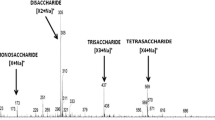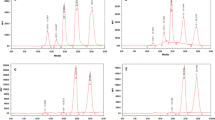Abstract
Short chain fructo-oligosaccharides (SC-FOS) are the potential prebiotics possessing diverse applications in both food and feed industries. The present study was aimed to extract inulin from chicory roots followed by its conversion into SC-FOS applying endoinulinase from Aspergillus fumigatus. The inulin was extracted from chicory roots through boiling in hot water, followed by precipitation with ethanol at room temperature or freezing condition. Maximum yield (42%) of inulin was obtained with three volumes of chilled absolute ethanol at room temperature. HPLC analysis of enzymatic hydrolysate detected kestose (GF2), nystose (GF3), and other FOS having higher degree of polymerization (DP). Maximum GF2 (5.79 mg/ml) was detected at temperature 50 °C, pH 5.5 with 2 U of enzyme dose after 6 h of hydrolysis; while maximum GF3 (4.33 mg/ml) was recorded at 60 °C, 5.5 pH with 0.5 U enzyme dose after 2 h of hydrolysis. Nevertheless, complete hydrolysis of inulin was noticed with 99% total oligosaccharide yield at 55 °C, 5.5 pH with 0.5 U enzyme dose after 4 h of hydrolysis with negligible amount of mono- and di-saccharides. The present finding demonstrated the process for higher yield of inulin from chicory roots followed by its conversion into SC-FOS applying fungal endoinulinase.







Similar content being viewed by others
References
Gibson, G. R., & Roberfroid, M. B. (1995). Dietary modulation of the human colonic microbiota: Introducing the concept of prebiotics. The Journal of Nutrition, 125(6), 1401–1412.
Stewart, M. L., Timm, D. A., & Slavin, J. A. (2008). Fructooligosaccharides exhibit more rapid fermentation than long-chain inulin in an in vitro fermentation system. Nutrition Research, 28(5), 329–334.
Bouhnik, Y., Raskine, L., Simomeau, G., Paineau, D., & Bornet, F. (2006). The capacity of short chain fructooligosaccharides to stimulate faecal Bifodobacteria: a dose response relationship study in healthy humans. Nutrition Journal, 5, 8.
Samanta, A. K., Jayapal, N., Senani, S., Kolte, A. P., & Sridhar, M. (2013). Prebiotic inulin: Useful dietary adjuncts to manipulate the livestock gut microflora. Brazilian Journal of Microbiology, 44(1), 1–14.
Tsai, Y. L., Lin, T. L., Chang, C. J., Wu, T. R., Lai, W. F., Lu, C. C., & Lai, H. C. (2019). Probiotics, prebiotics and amelioration of disease.Journal of Biomedical Science, 26, 3.
Csanadi, Z. S., & Sisak, C. S. (2008). Production of short chain fructo-oligosaccharides. Hungarian Journal of Industrial Chemistry, 36(1–2), 23–26.
Sangeetha, P. T., Ramesh, M. N., & Prapulla, S. G. (2005). Recent trends in microbial production analysis, and applications of fructooligosaccharides. Trends in Food Science and Technology, 16(10), 442–457.
Mussatto, S. I., Aguilar, C. N., Rodrigues, L. R., & Teixeira, J. A. (2009). Colonization of Aspergillus japonicus on synthetic materials and application to the production of fructooligosaccharides. Carbohydrate Research, 344(6), 795–800.
Nishizawa, K., Nakajima, M., & Nabetani, H. (2001). Kinetic Study on Transfructosylation by β-Fructofuranosidase from Aspergillus niger ATCC 20611 and availability of a membrane reactor for fructooligosaccharide production. Food Science and Technology Research, 7, 39–44.
Kosasih, W., Pudjiraharti, S., Ratnaningrum, D., & Pritani, S. (2015). Preparation of inulin from dahlia tubers. Procedia Chemistry, 16, 190–194.
Flores, C. A., Morlett, A. J., & Rodriguez, R. (2015). Inulin Potential for Enzymatic Obtaining of Prebiotic Oligosaccharides. Critical Reviews in Food Science and Nutrition, 56(11), 1893–1902.
Shang, H. M., Zhou, H. Z., Yang, J. Y., Li, R., Song, H., & Wu, H. X. (2018). In vitro and in vivo antioxidant activities of inulin. PLoS One, 13(2), e0192273.
Van Soest, P. J., Robertson, J. B., & Lewis, B. A. (1991). Methods for dietary fiber, neutral detergent fiber, and nonstarch polysaccharides in relation to animal nutrition. Journal of Dairy Science, 74(10), 3583–3597.
Zubaidah, E., & Akhadiana, W. (2013). Comparative study of inulin extracts from Dhalia, Yam and Gembili tubers as prebiotic. Food and Nutrition Sciences, 4(11A), 8–12.
Lingyuan, W., Jianhua, W., Xiaodong, Z., Da, T., Yalin, Y., Chenggang, C., Tianhua, F., & Fan, Z. (2007). Studies on the extracting technical conditions of inulin from Jerusalem artichoke tubers. Journal of Food Engineering, 79(3), 1087–1093.
Dubois, M., Gilles, K. A., Hamilton, J. K., Rebers, P. A., & Smith, F. (1956). Colorimetric method for determination of sugars and related substances. Analytical Chemistry, 28(3), 350–356.
Somogyi, M. (1952). ‘Notes on sugar determination’. The Journal of Biological Chemistry, 195, 19–23.
Naidoo, K., Kumar, A., Sharma, V., Permaul, K., & Singh, S. (2015). Purification and Characterization of an Endoinulinase from Xanthomonas campestris pv. phaseoli KM 24 Mutant. Food Technology and Biotechnology, 53(2), 146–153.
Ettalibi, B., & Baratti, J. C. (1987). Purification, properties and comparison of invertases, exoinulinases and endoinulinases of Aspergillus ficuum.Applied Microbiology and Biotechnology, 26(1), 13–20.
Li, A. X., Guo, L. Z., Fu, Q., & Lu, W. D. (2011). A simple and rapid plate assay for screening of inulin degrading microoranisms using Lugol’s iodine solution. African Journal of Biotechnology, 10 (46), 9518–9521.
R Core Team. (2014). R: A language and environment for statistical computing. Vienna, Austria: R Foundation for Statistical Computing.
Samanta, A. K., Singh, K. K., Das, M. M., Maity, S. B., & Kundu, S. S. (2003). Effect of complete feed block on nutrient utilization and rumen fermentation in Barbari goats. Small Ruminant Research, 48(2), 95–102.
Nwafor, I. C., Shale, K., & Achilonu, M. C. (2017). Chemical composition and nutritive benefits of chicory (Cichorium intybus) as an ideal complementary and or alternative livestock feed supplement. The Scientific World Journal. https://doi.org/10.1155/2017/7343928.
Kim, Y., Faqih, M. N., & Wang, S. S. (2001). Factors affecting gel formation of inulin. Carbohydrate Polymers, 46(2), 135–145.
Gupta, A. K., & Kaur, N. (2003). Preparation of inulin from chicory roots. Journal of Scientific and Industrial Research, 62(9), 916–920.
Tewari, S., Ramalakshmi, K., Methre, L., & Rao, L. J. M. (2015). Microwave-Assisted extraction of inulin from chicory roots using response surface methodology. Journal of Nutrition & Food Sciences, 5, 342.
Lopez-Molina, D., Navarro-Martinez, M. D., Rojas Melgarejo, F., Hiner, A. N., Chazarra, S., & Rodriguez-Lopez, J. N. (2005). Molecular properties and prebiotic effect of inulin obtained from artichoke (Cynara scolymus L.). Phytochemistry., 66, 1476–1484.
Ku, Y., Jansen, O., Oles, C. J., Lazar, E. Z., & Rader, J. I. (2003). Precipitation of inulins and oligofructose by ethanol and other solvents. Food Chemistry, 81(1), 125–132.
Moerman, F. T., Van Leeuwen, M. B., & Delcour, J. A. (2004). Enrichment of higher molecular weight fractions in inulin. Journal of Agricultural and Food Chemistry, 52(12), 3780–3783.
Melanie, H., Susilowati, A., Iskandar, Y. M., Lotulung, P. D., & Andayani, D. G. S. (2015). Characterization of inulin from local red Dahlia (Dahlia sp. L) tubers by infrared spectroscopy. Procedia Chemistry, 16, 78–84.
Rawat, H. K., Ganaie, M. A., & Kango, N. (2015). Production of inulinase, fructosyltransferase and sucrase from fungi on low-value inulin-rich substrates and their use in generation of fructose and fructo-oligosaccharides. Antonie Van Leeuwenhoek, 107(3), 799–811.
Singh, R. S., & Singh, R. P. (2010). Fructooligosaccharides from Inulin as Prebiotics. Food Technology and Biotechnology, 48(4), 435–450.
Singh, R. S., Singh, R. P., & Kennedy, J. F. (2016). Recent insights in enzymatic synthesis of fructooligosaccharides from inulin. International Journal of Biological Macromolecules, 85, 565–572.
Zhengyu, J., Jing, W., Bo, J., & Xueming, J. (2005). Production of inulooligosaccharides by endoinulinase from Aspergillus ficuum. Food Research International, 38(3), 301–308.
Mutanda, T., Wilhelmi, B. S., & Whiteley, C. G. (2008). Response surface methodology: Synthesis of inulooligosaccharides with an endoinulinase from Aspergillus niger. Enzyme and Microbial Technology, 43, 362–368.
Kim, D. H., Choi, Y. J., Song, S. K., & Yun, J. W. (1997). Production of inulo-oligosaccharides using endo-inulinase from a Pseudomonas sp. Biotechnology Letters, 19(4), 369–371.
Naidoo, K., Ayyachamy, M., Permaul, K., & Singh, S. (2009). Enhanced fructooligosaccharides and inulinase production by a Xanthomonas campestris pv. phaseoli KM 24 mutant. Bioprocess and Biosystems Engineering, 32(5), 689–695.
Cho, Y. J., Sinha, J., Park, J. P., & Yun, J. W. (2001). Production of inulooligosaccharides from chicory extract by endoinulinase from Xanthomonas oryzae No. 5. Enzyme and Microbial Technology, 28(4–5), 439–445.
Park, J. P., Bae, J. T., You, D. J., Kim, B. W., & Yun, J. W. (1999). Production of inulooligosaccharides from inulin by a novel endoinulinase from Xanthomonas sp. Biotechnology Letters, 21, 1043–1046.
Chen, M., Lei, X., Chen, C., Zhang, S., Xie, J., & Wei, D. (2014). Cloning, overexpression, and characterization of a highly active endoinulinase gene from Aspergillus fumigatus Cl1 for production of inulo-oligosaccharides. Applied Biochemistry and Biotechnology, 175(2), 1153–1167.
He, M., Wu, D., Wu, J., & Chen, J. (2014). Enhanced expression of endoinulinase from Aspergillus niger by codon optimization in Pichia pastoris and its application in inulooligosaccharide production.Journal of Industrial Microbiology & Biotechnology, 41, 105–114.
Jiang, X., Zhu, Y., Zhang, W., Guang, C., Zhang, T., & Mu, W. (2018). Efficient production of inulooligosaccharides from inulin by endoinulinase from Aspergillus arachidicola. Carbohydrate Polymers, 208(5), 70–76.
Nakamura, T., Shitara, A., Matsuda, S., Matsuo, T., Suiko, M., & Ohta, K. (1997). Production, purification and properties of an endoinulinase of Penicillium sp. TN-88 that liberates inulotriose Journal of Fermentation and Bioengineering, 84(4), 313–318.
Xu, Y., Zheng, Z., Xu, Q., Yong, Q., & Ouyang, J. (2016). Efficient conversion of inulin to inulooligosaccharides through endoinulinase from Aspergillus niger. Journal of Agricultural and Food Chemistry, 64(12), 2612–2618.
Hirabayashi, K., Kondo, N., Toyota, H., & Hayashi, S. (2017). Production of the functional trisaccharide 1-kestose from cane sugar molasses using Aspergillus japonicus β-fructofuranosidase. Current Microbiology, 74(1), 145–148.
Acknowledgments
The authors gratefully acknowledge the Council of Scientific and Industrial Research, Ministry of Science and Technology, Government of India (File No. 09/1158(0002)2K17) for awarding the Senior Research Fellowship.
Author information
Authors and Affiliations
Corresponding author
Ethics declarations
Conflict of Interest
The authors declare that they have no conflict of interest.
Additional information
Publisher’s Note
Springer Nature remains neutral with regard to jurisdictional claims in published maps and institutional affiliations.
Rights and permissions
About this article
Cite this article
Chikkerur, J., Samanta, A.K., Kolte, A.P. et al. Production of Short Chain Fructo-oligosaccharides from Inulin of Chicory Root Using Fungal Endoinulinase. Appl Biochem Biotechnol 191, 695–715 (2020). https://doi.org/10.1007/s12010-019-03215-7
Received:
Accepted:
Published:
Issue Date:
DOI: https://doi.org/10.1007/s12010-019-03215-7




